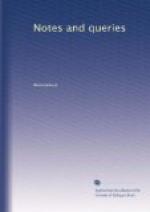Fuller (Ch. Hist., 17th cent., p. 610.) says that in his time “they had obtained the name of Ranters.”
Leslie, in his Works (vol. ii. p. 609.), considers the sect “identical with that of the Quakers.”
That this was not the case is evident, I conceive, from George Fox, the father of the Quakers, having severely chastised this “Family of Love,” because they would take an oath, dance, sing, and be cheerful. See Sewel’s History of the Quakers, iii. p. 88, 89, 344.
The founder of the sect, Henry Nicolai, was born at Munster, and commenced his career about 1546 in the Netherlands; thence he passed over to England, in the latter years of Edward VI.’s life, and joined the Dutch congregation. But his sect did not become visible till some time in the reign of Elizabeth.
In 1575 they presented a confession of their faith to parliament, along with a number of their books, and prayed toleration.
Nicolai, or Nicolas, their founder, published a number of tracts and letters in Dutch for the edification of his followers: and now I will propose a Query, in hopes that some of your correspondents will solve it. Is there extant any list of their writings as presented to parliament in 1575, and has their confession been published, and when? Perhaps the following works, none of which I am able to consult, would furnish the means of solving my Query, all of which treat of the subject:—
J. Hombeck’s Summa Controversiarum. Godfr. Arnold’s Kirchen- und Kitzer-historie. Ant. Wilh. Bohm’s Englische Reformations-historie. Schroekh’s Kirchengesch. seit der Reformation.
{202}
These sources would, I conceive, be useful to N.B., who inquires into their tenets and lives.
I find I have omitted to mention one of their assailants, “the last and most learned,” Henry More, the English divine. See his Mystery of Godliness, book vi., chap. 12-18.
[Hebrew: SP’T]
The Family of Love.—In addition to the work of John Rogers, referred to by DR. RIMBAULT (Vol. ii., p. 49.), the two following treatises, which were also published in the year 1579, will present your readers with much curious information respecting the “Family of Love.” The first is entitled,—
“A Confutation of certaine Articles delivered unto the Familye of Loue, with the exposition of Theophilus, a supposed elder in the sayd Familye, upon the same Articles, by William Wilkinson, Maister of Artes, and student of Divinitye, &c. &c. At London: Printed by John Daye, dwelling ouer Aldersgate, Au. 1579.”
In the Epistle Dedicatorie, dated Cambridge, September 30, 1579, and addressed to Richard (Cox), Bishop of Ely, the author describes the new doctrine as,—
“The most pestiferous and deadly Heresie of all others, because there is not almost any one particular erroneous and schismaticall phantasie, whereof the Familie of Loue hath not borrowed one braunche or other thereof, to peece vnto themselves this their Religion.”
A passage is then added which may serve in some measure as a reply to N.B. (Vol. ii., p. 89.) It seems to slow that, however vile might be the theology of this sect, their morals were not at least publicly offensive.




